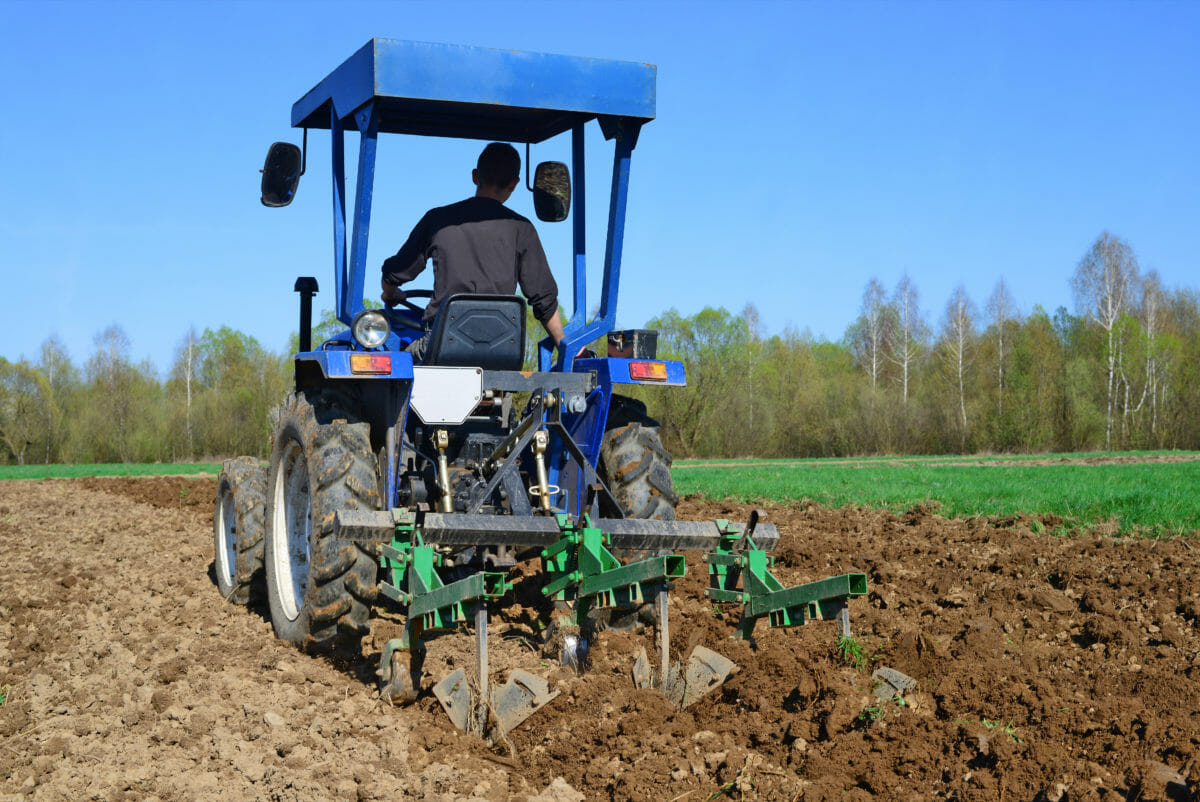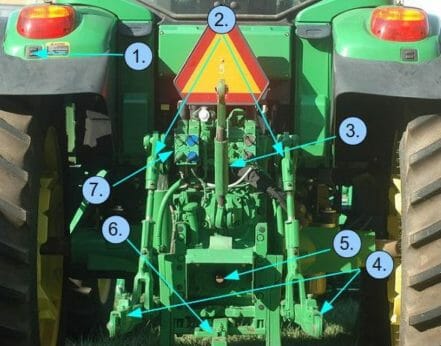In which you will learn how to use terms like "power takeoff” and "three-point hitch” in a sentence.

A Primer on Hitches
To really show off your farm cred, you need to be fluent in hitch-speak: how implements are attached to tractors, that is. One hundred years ago, the only option was to drag plows and other implements behind a tractor, in the same way that they were dragged behind horses. Things have come a long way.

1. PTO controls 2. Hydraulic arms 3. Center hitch (of three-point hitch) 4. Bottom hitches (of three-point hitch) 5. Power takeoff (PTO) 6. Drawbar 7. Hydraulic controls / Photo from wikimedia.org/wiki/File:A_Tractor%27s_rear_1.jpg
Drawbar: A horizontal bar bolted to the back of a tractor to which various implements can be mounted. Drawbars were the standard hitch on early tractors, and are still occasionally used today.
Three-Point Hitch: A system with three points of connection, arranged in a triangular layout, between a tractor and an implement. Three-point hitches, which provide greater stability than drawbars and can connect to a much wider range of implements, have been the standard type of tractor hitch since the 1940s.
Hydraulics: Oil-filled, pressurized tubes that power “arms” on the back of a tractor (and often the front) that are used to manipulate implements. Two of the three points of a three-point hitch are typically at the end of hydraulic arms that are used to lower implements to the ground and raise them when not in use.
Power Takeoff: A spinning shaft powered by the tractor engine that is used to turn rotating implements such as mowers and tillers. Power takeoffs, which are typically integrated with a three-point hitch at the rear of a tractor, are notoriously dangerous: many farmers have been maimed or killed when their clothing became caught in the PTO shaft.
Implement Dictionary
Here is a sampling of the tools that can be mounted on the front or back of a tractor. Some require PTO or hydraulic power; others are “ground-driven,” meaning the implement is activated simply by dragging it across the earth. NOTE: Though posthole diggers, stump grinders, backhoes, and snow blowers are fun toys to mount on your John Deere, we’ve left those out in favor of implements that have a direct connection to agriculture.
Bed Shaper: A tool that forms tilled soil into raised beds with furrows between them. Bed shapers are often used before planting vegetables to create deeper, better-drained beds than is possible simply with tilling.
Disk Harrow: A series of round blades that loosen soil, destroy weeds, and chop up crop residue. Disks do not the loosen the soil the depths possible with a tiller or plow but are used for seeding grains and other crops where deep tillage is not required.
Hay Baler: A large implement that forms compressed bales when pulled over rows of dry hay (most balers are PTO-powered). Different balers are used to make small rectangular bales versus large cylindrical bales; the latter requires a larger tractor.
Hay Rake: An implement that pulls hay into rows after it has been dried in the field (both ground-driven and PTO-powered models are available). Raking hay into rows is the intermediate step between tedding, which helps the hay to dry, and baling.
Hay Tedder: An implement with many small spinning tines that fluffs up and turns over freshly cut hay (both ground-driven and PTO-powered models are available). A tedder makes hay dry faster, preventing it from becoming moldy.
Loader: A bucket mounted to the front of a tractor that is used to move compost, soil, brush, livestock feed and other materials around a farm. Loaders, which give tractors capabilities similar to a small bulldozer, are powered by a hydraulic system.
Manure Spreader: A cart pulled behind a tractor in which spinning blades force the contents (manure or compost) out the back (both ground-driven and PTO-powered models are available). Manure spreaders are designed to evenly distribute the material across a field.
Plow: Steel shanks that are pulled behind a tractor to loosen the earth in preparation for planting. The various types of plows – chisel and moldboard are the most common – are old-fashioned cultivation tools that are still widely used; unlike tillers, plows are simply pulled behind a tractor and do not require power from a PTO.
Ripper: A long steel shank (also referred to as a subsoiler) that loosens the soil to a much greater depth than other implements, but does not mix the surface layers of the soil like a tiller. Rippers, which are used to break up “hard pan” soil to improve drainage and allow roots to penetrate more deeply, may be used singly or with several mounted together on a large rack.
Roller Crimper: A large cylindrical implement used to crush existing vegetation (typically a cover crop) in a field so that seed may be planted directly without any other form of tillage or cultivation. Because they do not disturb the soil, roller crimpers are a popular implement on “no-till” farms; they are often mounted on the front of a tractor, while a rear-mounted seed drill simultaneously plants the crop.
Rotary Mower: A PTO-powered mower with thick, dull blades that is used to chop down heavy brush, rather than grass. Popularly referred to as a bush hog (which is a brand of rotary mowers), this maintenance tool is often used to keep pastures from reverting to forest.
Seed Drill: An implement that deposits seeds into the ground and covers them with soil (both ground-driven and PTO-powered models are available). Seed drills are adjustable to accommodate the required planting depth and spacing of different crops.
Sickle Bar Mower: A mower with a blade that extends off to one side of the tractor, making it possible to maintain ditches, pond edges and other areas where it would be unsafe to drive a tractor. Sickle bar mowers, along with disk and drum mowers, are often used to cut hay.
Sprayer: A pressurized tank used to distribute liquid pesticides and fertilizers (both organic or synthetic forms). Sprayers, which are typically PTO-powered, are either mounted on the back of a tractor or pulled on a cart.
Spreader: A hopper with a spinning disk at the bottom that is used to distribute fertilizer or seed evenly across a field. Spreaders, which are typically PTO-powered, are either mounted on the back of a tractor or pulled on a cart.
Spring-Tooth Harrow: Curved blades that break up the surface of the soil to remove weeds and prepare for planting. Spring-tooth harrows are often used as a final stage of tillage to create a fine seedbed.
Tiller: A PTO-powered tool with a series of angled blades that rotate rapidly, loosening soil and destroying weeds in preparation for planting. Tiller blades, also referred to as tines can loosen the soil to a depth of 6 inches or more, which is necessary for planting most vegetables.
Agriculture